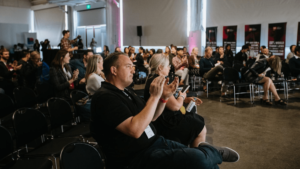Your event website is a great way to gain the visibility you need to attract the largest, most engaged attendees. But no matter how good your website may be, there are always ways to improve it.
To engage the widest audience possible, you’ll need to measure — and improve upon — the effectiveness of your website’s design and functionality. Here’s a quick breakdown of five strategies you can use to ensure that the quality of your website meets the quality of your event.
1. Web analytics
To maintain a successful event website, you need to keep track of how many people are visiting your site — and how they found it. Without this information, you will have no idea if your website is turning visitors into paid attendees. Google Analytics is the most essential web analytics tool today.
Put simply, If you’re not using web analytics, then you have no idea how effective your site is at selling your event.
2. A/B testing
A/B testing allows you to compare two versions of a webpage against one another, allowing you to see which one is engaging your audience more. These tests can show you which images or words cause visitors to purchase or not.
A/B testing used to require a lot of technical skill, but thanks to services like Optimizely, you can experiment with different headlines, calls to action, and design features — without relying on developers.
3. Heat mapping
Heat mapping provides you with a visual representation of where people click the most on your site, and how far they’re scrolling down the page. These colour coded maps show you what areas of your site are most interesting to your visitors. Heat mapping tools like Crazy Egg can also provide an easy way to uncover problems in your site that may have gone unnoticed.
Imagine that you’ve repeatedly asked a question that is answered towards the bottom of your site. A scroll-tracking heat map would inform you that a small percentage of people make it that far and that you should place this information further up the page.
4. Usability testing
First impressions often last the longest. That’s why it’s critical to help web visitors understand and engage with your content as quickly as possible. Take advantage of tools like Usability Hub’s Five Second Test to understand your visitor’s experience
The service measures people’s first impressions by showing them your design for five seconds. When the time is up, they’re asked questions about what they remember. If testers fail to recall your event website’s primary messaging (like date range and location), you may need to rework your design or copy.
5. Attendee feedback
Traditional methods for understanding your website’s performance are often still the most effective. Some of the most in-depth insight you can get on your website comes from asking real people what it was like to learn about and sign up for your event.
After your event, send out a post-event survey to attendees using SurveyMonkey and ask them how they learned about your event. If attendees who learned about your event from the website weren’t satisfied with the information they received, then you probably need to rethink your site content or design. You can also speak to attendees on the ground at your event and ask how they found the event website and what convinced them to purchase a ticket or register.
Every event website is a work in progress. Even the most successful sites can be improved with continued testing and optimisation. Keep refining your message and design and you will be amazed at the level of engagement your website can drive.
Want to learn more about creating a compelling event website? Download the free guide, Create an Event Website That Will Sell Out Any Event.





